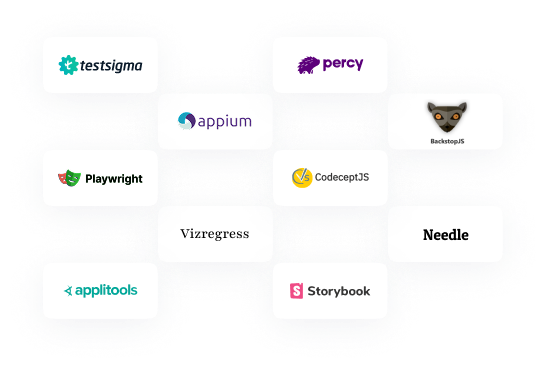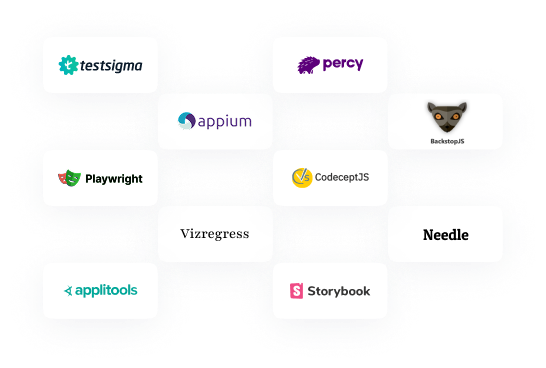Not all visual testing tools are built the same; some focus on precision, while others prioritize speed or AI-driven insights. This comparison breaks down how the best visual testing tools stack up across accuracy, automation, and usability.
Table Of Contents
- 1 Comparison of the 5 Best Visual Testing Tools
- 2 12 Best Visual Testing Tools in 2025
- 3 Factors to Consider While Choosing the Best Visual Testing Tool
- 4 Conclusion
Comparison of the 5 Best Visual Testing Tools
| Tool | Description | Key Visual Testing / AI Features |
| Testsigma | A no-code, Agentic AI-driven test automation platform for end-to-end autonomous testing across web, mobile, API, ERP, and desktop applications. | • Create visual tests in plain English using NLP. Use the Generator Agent to create tests from Jira, Figma, images, videos, and docs.• Run visual and functional tests in parallel.• Visual regression via screenshot comparison across 3,000+ browsers and devices.• Highlights visual differences between baseline and current UI for easy debugging. |
| Applitools | A dedicated AI-powered visual testing platform that focuses on intelligent visual validation for web, mobile, and documents. | • Visual AI engine that understands layout and content, not just pixels.• Smart baseline management to minimize false positives.• Cross-browser and cross-device visual testing.• Automated maintenance of baselines for faster review cycles. |
| BackstopJS | An open-source visual regression testing tool designed for web apps and responsive designs. | • Configuration-driven screenshot capture and comparison.• Supports multiple browsers and viewport sizes.• Integrates with CI/CD pipelines for automated visual regression testing.• Generates reports with highlighted visual diffs. |
| Percy | A visual testing and review platform (by BrowserStack) that automates UI comparison in the development workflow. | • Automates screenshot capture and visual diffing per commit.• Integrates seamlessly with CI/CD for visual regression testing.• Cross-browser visual testing for multiple environments.• Provides a review dashboard for teams to inspect and approve changes. |
| Aye Spy | An open-source visual regression tool for comparing web UIs through automated snapshots. | • Captures screenshots and compares them with baseline images.• Detects and highlights visual changes across builds.• Supports parallel comparisons and external storage of snapshots.• Lightweight setup with fast image diffing capabilities. |
12 Best Visual Testing Tools in 2025
Testsigma

Testsigma is a no-code, Agentic AI-powered test automation platform designed for comprehensive end-to-end testing across web, mobile, API, desktop, and ERP systems like SAP and Salesforce. It integrates visual testing with functional testing, enabling teams to detect UI anomalies alongside traditional functional issues.
Features
- AI-driven visual regression testing that identifies UI discrepancies across 3,000+ browsers and devices.
- Parallel execution of visual and functional tests for efficient test cycles.
- Snapshot-based visual comparisons with highlighted differences for easy analysis.
- Integration with CI/CD pipelines for continuous visual validation.
Pros
- No-code interface accessible to both technical and non-technical users.
- Comprehensive cross-platform visual testing capabilities.
- AI-powered self-healing tests reduce maintenance efforts.
Cons
- Initial setup may require some learning curve for new users.
- Performance may be affected by internet connectivity.
CodeceptJS
CodeceptJS is an open-source, behavior-driven testing framework for Node.js applications. It offers visual testing capabilities through integration with tools like Resemble.js.

Features
- Integration with Resemble.js for pixel-by-pixel image comparison.
- Scenario-driven approach for writing tests from the user’s perspective.
- Support for multiple backends including Playwright, WebDriver, and Puppeteer.
Pros
- Readable and maintainable test syntax.
- Flexible backend support for diverse testing needs.
- Active open-source community with regular updates.
Cons
- Requires additional configuration for visual testing setup.
- Limited out-of-the-box visual testing features compared to dedicated tools.
Applitools
Applitools is a cloud-based visual testing platform powered by AI, designed to automate visual validation across web and mobile applications.

Features
- Visual AI engine for detecting visual bugs across different browsers and devices.
- Single-line code integration for visual validation.
- Cross-browser and cross-device visual testing capabilities.
Pros
- High accuracy in detecting visual discrepancies.
- Scalable solution suitable for large applications.
- Comprehensive dashboard for visual test results.
Cons
- Pricing may be a consideration for small teams.
- May require initial setup and configuration.
Appium
Appium is an open-source test automation framework for mobile applications. It supports visual testing through image comparison techniques.

Features
- Integration with image processing libraries like OpenCV for visual validation.
- Cross-platform support for Android and iOS applications.
- Ability to capture screenshots and compare them against baseline images.
Pros
- Supports both native and hybrid mobile applications.
- Active open-source community with extensive documentation.
- Flexible and extensible framework.
Cons
- Requires additional setup for visual testing capabilities.
- Image comparison may not be as advanced as specialized visual testing tools.
BackstopJS
BackstopJS is an open-source visual regression testing tool designed for web applications. It automates the process of capturing and comparing screenshots to identify visual discrepancies.

Features
- Configurable scenarios for capturing screenshots of web pages.
- Integration with headless browsers like Chrome for rendering.
- Comparison of screenshots against baseline images to detect visual changes.
Pros
- Open-source and free to use.
- Highly customizable configuration options.
- Supports integration with CI/CD pipelines.
Cons
- Requires manual setup and configuration.
- Limited out-of-the-box features compared to commercial tools.
Percy
Percy is a visual testing and review platform that integrates with your CI/CD pipeline to automate visual testing and catch visual regressions early in the development process.

Features
- Automated screenshot capture and comparison against baseline images.
- Integration with various CI/CD tools for continuous visual testing.
- Visual review interface for team collaboration on visual changes.
Pros
- Seamless integration with existing development workflows.
- User-friendly interface for visual change reviews.
- Supports cross-browser visual testing.
Cons
- Subscription-based pricing model.
- May require initial setup and configuration.
Aye Spy
Aye Spy is a visual regression testing tool that captures screenshots of web pages and compares them to baseline images to detect visual discrepancies.

Features
- Screenshot comparison with baseline images to identify visual changes.
- Integration with Selenium Grid for parallel testing.
- Support for cloud storage solutions like AWS S3 for storing snapshots.
Pros
- High-performance image comparison capabilities.
- Simple configuration and setup.
- Supports parallel testing for faster execution.
Cons
- Requires Selenium Grid for distributed testing.
- Limited out-of-the-box features compared to commercial tools.
Playwright
Playwright is an open-source automation framework for end-to-end testing of web applications. It includes built-in support for visual testing through screenshot comparisons.

Features
- Built-in support for capturing and comparing screenshots.
- Integration with CI/CD pipelines for continuous visual testing.
- Support for multiple browsers including Chromium, Firefox, and WebKit.
Pros
- Fast and reliable test execution.
- Comprehensive browser support.
- Active open-source community with regular updates.
Cons
- Requires additional setup for visual testing capabilities.
- May not be as feature-rich as specialized visual testing tools.
Hermione.js
Hermione.js is a browser automation framework for Node.js applications. It offers visual testing capabilities through integration with tools like Resemble.js.

Features
- Integration with Resemble.js for image comparison.
- Support for multiple browsers including Chrome and Firefox.
- Scenario-driven approach for writing tests.
Pros
- Lightweight and easy to set up.
- Flexible configuration options.
- Active open-source community.
Cons
- Requires additional configuration for visual testing setup.
- Limited out-of-the-box visual testing features.
Needle
Needle is an open-source visual regression testing tool that captures screenshots and compares them to baseline images to detect visual discrepancies.

Features
- Pixel-by-pixel image comparison for visual regression testing.
- Support for multiple image formats.
- Integration with CI/CD pipelines for continuous visual testing.
Pros
- Open-source and free to use.
- Simple configuration and setup.
- Supports integration with CI/CD pipelines.
Cons
- Limited features compared to commercial tools.
- Requires manual setup and configuration.
Vizregress
Vizregress is a visual regression testing tool that automates the process of capturing and comparing screenshots to identify visual discrepancies.

Features
- Automated screenshot capture and comparison against baseline images.
- Integration with CI/CD pipelines for continuous visual testing.
- Support for multiple browsers and devices.
Pros
- Automated visual regression testing capabilities.
- Scalable solution suitable for large applications.
- Supports cross-browser and cross-device visual testing.
Cons
- May require manual configuration for advanced scenarios.
- Limited community support compared to open-source tools.
Storybook
Storybook is a UI component development environment that also offers visual testing capabilities through add-ons and integrations like Chromatic. While primarily for component development, it enables teams to catch visual regressions during UI development.

Features
- Automated snapshot testing for UI components.
- Visual regression detection through Chromatic integration.
- Component-level testing across different states and interactions.
- Integration with CI/CD pipelines for continuous validation.
Pros
- Excellent for component-driven development.
- Captures visual regressions early in the development cycle.
- Supports collaboration between developers and designers.
Cons
- Requires additional setup for full visual testing.
- Not a standalone visual testing tool; relies on add-ons like Chromatic.
Factors to Consider While Choosing the Best Visual Testing Tool
- Ease of Setup and Use: The tool should have a minimal setup process and an intuitive interface. A steep learning curve can slow down adoption, especially for non-technical testers.
- Visual Accuracy: Choose tools that can detect layout shifts, color mismatches, or missing elements precisely, without triggering false positives from minor pixel differences.
- Cross-Browser and Cross-Device Coverage: Ensure the tool supports testing across all major browsers, devices, and screen resolutions that your users rely on.
- Integration with CI/CD Pipelines: The tool should integrate seamlessly with your existing CI/CD systems like Jenkins, GitHub Actions, or Bitbucket, to enable continuous visual validation during deployments.
- AI and Smart Detection Capabilities: Tools with AI-driven visual comparison can intelligently differentiate between real bugs and acceptable design changes, reducing noise and manual review.
- Baseline and Version Management: Effective baseline management helps handle frequent UI updates without breaking tests or requiring constant manual approvals.
- Performance and Scalability: The tool should handle large-scale visual regression suites without slowing down builds or increasing execution time significantly.
- Collaboration and Review Workflows: Look for features that allow teams (QA, Dev, and Design) to review, comment, and approve visual changes collaboratively within the tool.
- Open-Source vs. Paid: Consider your budget and maintenance bandwidth. Open-source tools like BackstopJS or Aye Spy offer flexibility but require manual setup; paid tools like Testsigma or Applitools come with AI assistance and managed environments.
- Maintenance Effort: Opt for tools that support self-healing or automated baseline updates to minimize ongoing maintenance, especially when UIs change frequently.
- Reporting and Analytics: Clear, visual reports with highlighted diffs, historical trends, and pass/fail insights make debugging faster and stakeholder communication easier.
- Security and Data Privacy: For enterprise apps, confirm that the tool ensures secure data handling, especially if screenshots or UI data contain sensitive information.
Conclusion
In 2025, visual consistency is just as important as functionality. The tools you pick should not only detect layout shifts and UI anomalies but also fit smoothly into your CI/CD and collaboration workflows. Whether you prefer a codeless AI platform or an open-source setup, what matters most is having a visual testing tool that evolves with your product and your team. If you want to leverage the power of Agentic AI for your visual testing, try it with a free trial today.

